American Pravda
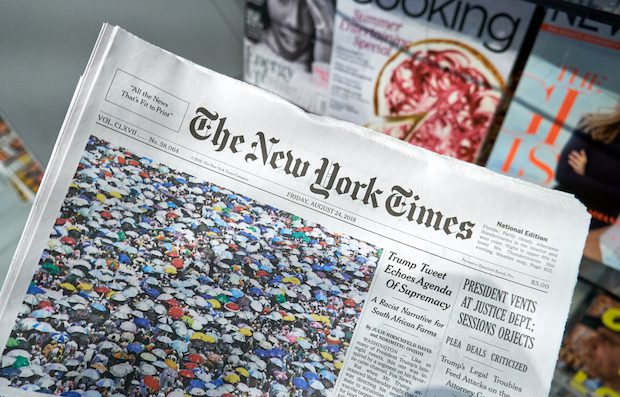
Another day, another example of The New York Times advancing the cultural revolution:
Ever since El Martinez started asking to be called by the gender-neutral pronouns “they/them” in the ninth grade, they have fielded skepticism in a variety of forms and from a multitude of sources about what it means to identify as nonbinary.
There are faculty advisers on El’s theater crew who balk at using “they” for one person; classmates at El’s public school on the outskirts of Boston who insist El can’t be “multiple people”; and commenters on El’s social media feeds who dismiss nonbinary gender identities like androgyne (a combination of masculine and feminine), agender (the absence of gender) and gender-fluid (moving between genders) as lacking a basis in biology.
Even for El’s supportive parents, conceiving of gender as a multidimensional sprawl has not been so easy to grasp. Nor has El’s suggestion that everyone state their pronouns gained much traction.
More:
So last summer, when the Massachusetts State Legislature became one of the first in the nation to consider a bill to add an “X” option for nonbinary genders to the “M” and “F” on the state driver’s license, El, 17, was less surprised than some at the maneuver that effectively killed it.
Beyond the catchall “X,” Representative James J. Lyons Jr. (he/him), a Republican, had proposed that the bill should be amended to offer drivers 29 other gender options, including “pangender,” “two-spirit” and “genderqueer.” Rather than open the requisite debate on each term, leaders of the Democratic-controlled House shelved the measure.
“He articulated an anxiety that many people, even folks from the left, have: that there’s this slippery slope of identity, and ‘Where will it stop?’” said Ev Evnen (they/them), director of the Massachusetts Transgender Political Coalition, which is championing a new version of the bill.
As the first sizable group of Americans to openly identify as neither only male nor only female has emerged in recent years, their requests for recognition have been met with reservations that often cross partisan lines. For their part, some nonbinary people suggest that concerns about authenticity and grammar sidestep thornier questions about the culture’s longstanding limits on how gender is supposed to be felt and expressed.
“Nonbinary gender identity can be complicated,” said Mx. Evnen, 31, who uses a gender-neutral courtesy title. “It’s also threatening to an order a lot of people have learned how to navigate.”
“They/them”. “Mx”. The Times not only advances this dissolution by the things it chooses to advocate in its news judgment, but by the language it uses. For the most influential news organization in America, this matters.
And this has been going on at an intense level for the past five or six years — in the news media in general, and in particular at The New York Times. In a jaw-dropping Twitter thread, Zach Goldberg nails them. Here is a link to his entire thread, which I strongly encourage you to read. He spent some time over the weekend with the Lexis/Nexis database, searching the frequency of use of particular terms in the database (which archives text from the media sources). Excerpts:
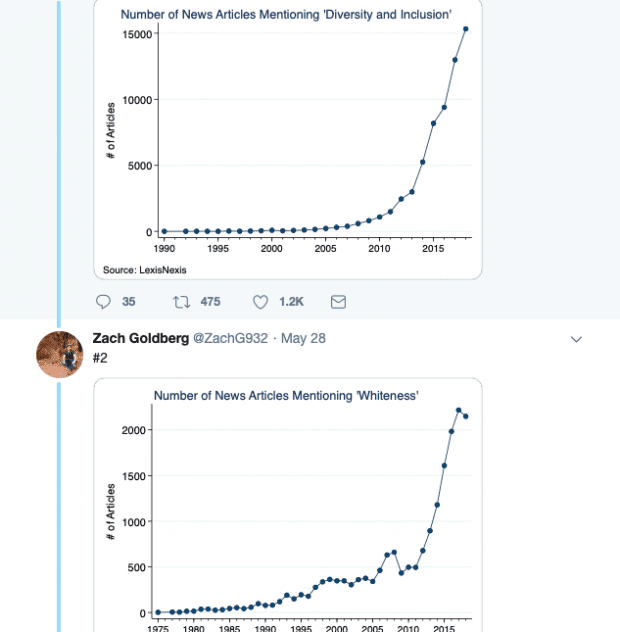
More:
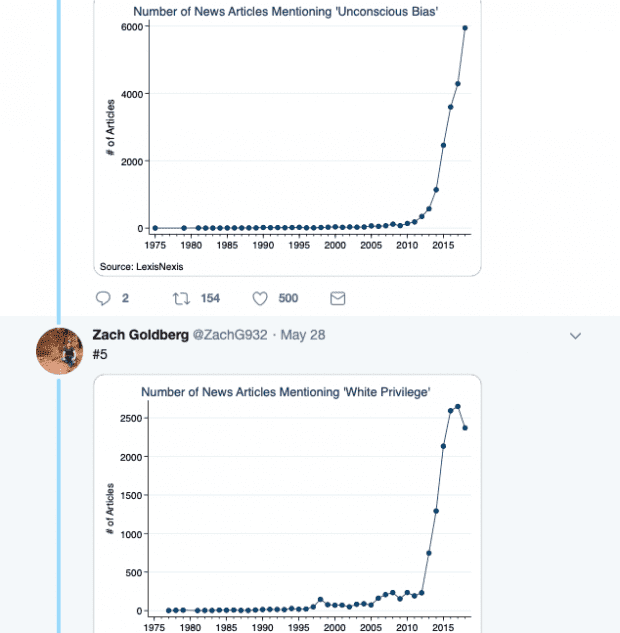
And:
(#6) So many of these graphs look the same that, without the title, it looks like I’m simply reposting a single chart pic.twitter.com/iEoKxpubi1
— Zach Goldberg (@ZachG932) May 28, 2019
https://platform.twitter.com/widgets.js
Then he starts limiting his search to a single news source, on the grounds that maybe these particular terms are only showing up so many more times because Lexis/Nexis is cataloguing more sources. Goldberg sticks to The New York Times. Lo, the charts all look like these below!:
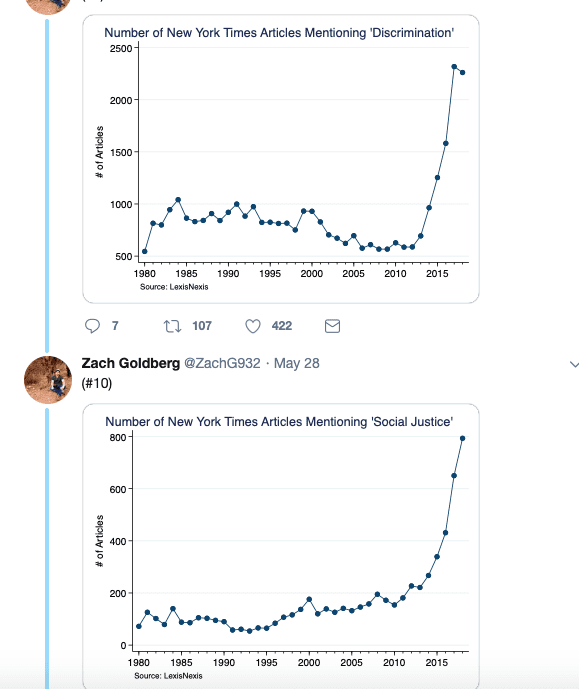
Please, read the entire thread. It will knock you flat. This is hard evidence that our news media, especially our most important news source (because the Times sets the agenda for so many others, especially network and cable television), went ideologically mad around 2012 — four years before Trump was elected, note well — and began to propagandize for left-wing identity politics.
It’s not right-wing hysteria: the Times, and others (remember, Goldberg started out with a general Lexis/Nexis search), really are out to create a new reality through propaganda. They neither understand nor like their own country, so they’re trying to create a new one. It’s as if the commissars took over the news media, and the Times, and engineered coverage to be a constant flow of Social Justice Wartime propaganda.
Is the Washington Post all that different? I’d like to know.
As you longtime readers know, I’m working on a book about what we can all learn from the experience of people under Soviet and Eastern-bloc communism, about how to identify and resist the soft totalitarianism of our own time and place. This data Zach Goldberg has unearthed is stunning evidence that the media, always liberal, have become ideologically supercharged — and started several years before Donald Trump emerged as a politician.
All right-thinking liberals are freaking out over Facebook not doing a good job (according to them) in managing political propaganda, like the fake Pelosi slurring video. But good grief, what about the sophisticated political propaganda masquerading as neutral coverage of race, diversity, and society? I would love to see somebody with access to Lexis/Nexis do a similar search on terms like “gender binary,” “queer,” and so forth. I have no doubt that the same evidence of crusading propaganda will emerge.
Whenever you hear the American news media talk about “diversity,” you should know that it’s code language meaning narrowing the bounds of discourse to exclude anyone not on the side of Social Justice Warriors. I mean, look, we knew that already, but now we have hard evidence.
Consider this: if a Lexis/Nexis database search showed a similar stratospheric rise in mainstream media of the use of terms and concepts associated with the hard right, wouldn’t you think something crazy was going on? Wouldn’t you suspect that newsrooms had been captured by ideologues? Wouldn’t you lose a lot of trust and confidence in the version of reality brought to you by mainstream media? I would. What are they manufacturing? What are they inciting?
Do these people even understand the country they’re reporting on? I cannot believe that NYT publisher A.G. Sulzberger, 38, can look at those graphs and not be shocked and appalled by what is happening in his newsroom. I’m probably wrong about that.
UPDATE: An Aussie reader writes:
Thank you for your consistently interesting and thought- provoking blog. I always enjoy reading it.
Just for fun, I looked up the use of the term “Benedict option” over time from 1995-2017 using the same LexisNexis database that Goldberg quotes.
Unsurprisingly, you will see almost exactly the same shaped graph as the ones you posted. I certainly don’t think that you would come to the conclusion that the American news media are trying to propagandise your views! Of course it simply represents an increase in usage of (and interest in) that new idea. In case you are wondering, the 1995 use of the ”Benedict option” was referring to ordering eggs at a restaurant.
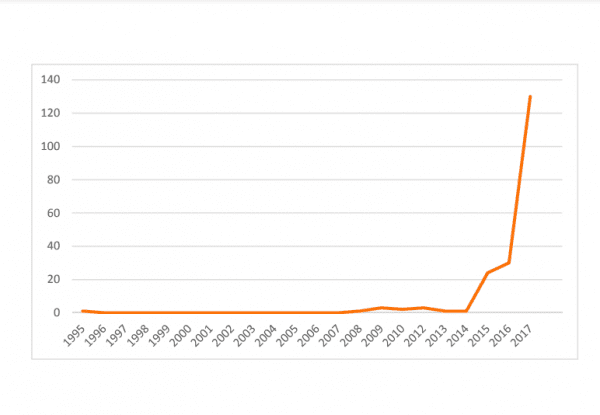
A fair point! But the term did not exist until I started using it, and wrote a book about it. The terms “discrimination,” “inclusion,” and “social justice” have been around for a long time. Not sure about “whiteness,” but the fact that it went from a minor field of study in fringe academia to mass media phenomenon, quadrupling the number of articles in only three years (again, pre-Trump!), tells me that something else is going on. Also, there were 130 articles about the “Benedict Option” at its peak; there were over 2,000 on “whiteness” at its peak.
It’s an interesting question, though: at what point do particular phenomena become “news” because major media are paying attention to it? Wait, that’s a circular way to frame the question. Of course something is “news” only if news media pay attention. What I’m asking is to what extent is a phenomenon artificially inflated by media attention? Or, more interestingly, to what extent does a relatively minor phenomenon become major because the media decide to keep banging away on it?
A classic study on this appeared around the turn of the century, from two Baruch College professors, whose names I can’t remember. If somebody can find a link to the study, put it in the comments and I’ll post it. They went through the archives of major media from around 1980 until the present day (then, around 1998 or so), looking to see how the media covered the rise of the religious conservatism in the GOP. They found gobs of articles — which were justified, because the rising political influence of the Religious Right really was a significant phenomenon. But the professors also found that the media entirely missed the concomitant rise of the Secular Left in the Democratic Party. Their hypothesis was that because journalists are overwhelmingly on the left, they could not see the parallel phenomenon, because it just seemed normal to them.
Back in 2012, surveys showed that the American public consistently, and massively, overestimated the size of the gay and lesbian population. Makes sense, if you judged the size of the gay and lesbian community by the media attention to them.